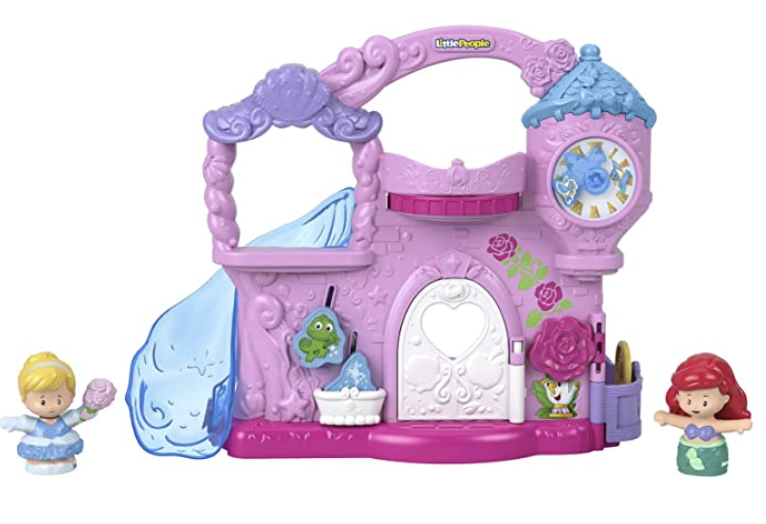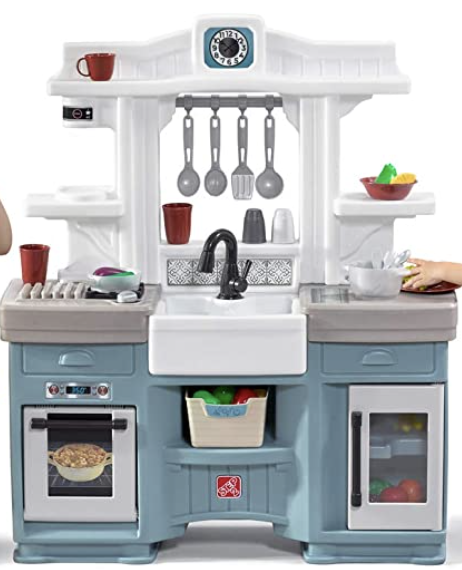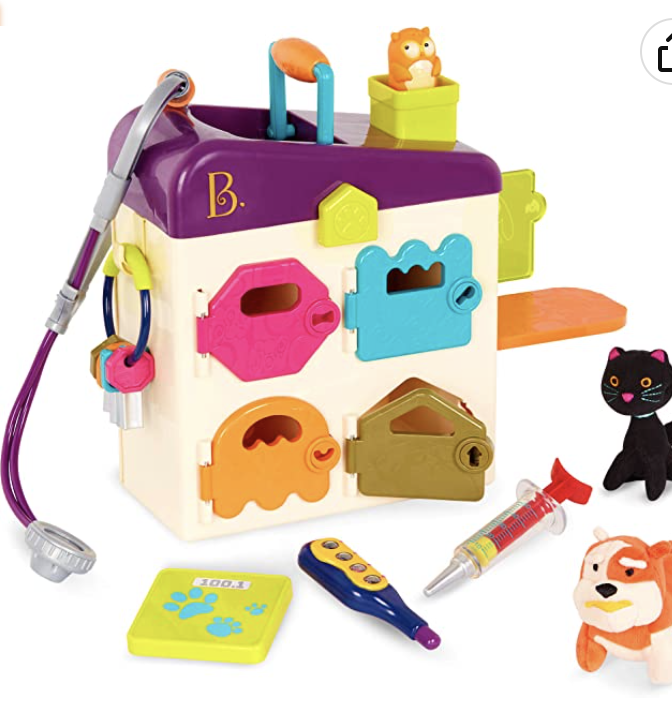Preschooler Toy Guide
3-5 Year Olds
These toys are some of my favorites for preschoolers! Your child will strongly benefit from you playing together with them. You can model how to play with the toy, and then let your child’s imagination take over! This is one of the many reasons that playing with your child is extremely beneficial for their language development. Toys that are great for this age are ones that your child can start expanding their pretend play skills with. At this age, your child can enjoy toys where they are able to imitate daily routines (e.g. cooking, cleaning, eating), continue to expand their fine motor skills, and begin to act out imaginative play. Around 3-4 years of age, your child may enjoy playing side-by-side with other children while participating in associated play tasks, and by 4-5 years old, your child may start engaging in play together with other children in a more cooperative way.
As an Amazon Associate, we earn from qualifying purchases. This means that at no additional cost to you, if you make a purchase through certain links on this site or any related social media platforms, we may make a small commission. We only feature products that we believe in and use ourselves. Your support means the world to us and allows us to host this website. Thank you!
Magnet Tiles
Magnet tiles are a great toy for preschoolers. You can work on colors, shapes, and sizes (e.g. get me the big green triangle, where is the small purple square?), and early engineering skills! Your preschooler can work on problem solving to figure out which shapes fit together to build different creations. Not only can your child work on their building skills, they can then use their creations in their imaginative play (e.g. building a house for their toys, building a rocket ship). You can also work on multistep directions (e.g. First get a triangle, then put it on the square). While 3 year olds can start enjoying this toy, magnet tiles can grow with your kiddo into their elementary school years!
60 piece set
130 pieces Deluxe Set
Play Cookies
Play cookies are always a hit with my preschoolers. You can work on following multistep directions (e.g. First cut the cookie, then put it on the pan; First put on chocolate frosting, then give me a vanilla cookie), matching (find all the frostings that look the same), describing (e.g. The green and chocolate cookie, the vanilla cookie with sprinkles), and pretend play skills (e.g. pretending to bake the cookies in the oven, decorate them, serve them at a tea party, etc.).
Doll House
A doll house is a fantastic toy for preschoolers. You can act out daily routines with the people, narrate what the people are doing, and have the people talk to each other. This provides your preschooler with language learning opportunities that pertain directly to their daily lives. Use the same verbal routines you use in “real life” during play in the doll house. For example, “time to eat,” “turn the lights on,” “time for bed,” “goodnight ____,” “wake up,” “Down the stairs, down down down.”
Little People Doll House
Wooden Doll House
Play Food Sets
Play food sets offer up a huge selection of variety, and many imaginative play opportunities. You can pretend to order food from your little one, work on following 1-3 step directions, and switch roles and have your little one order something from you. They can practice their descriptive language, and telling you how to do something (e.g. First get the bread, then put on the cheese). These are great to add to a play kitchen, or play with on their own! Some sets even come with picture cards to help your child follow directions.
Toy Swing Set
Toy swing sets are great, because you can model words and actions that your preschooler can hear and use in the “real-world.” You can narrate what the character’s are doing (e.g. “She’s climbing up the ladder, she’s ready to slide down, ready, set, go!”), and act out social scenarios your preschooler might encounter at the real playground (e.g. “Can I have a turn on the swing?”)
Little People Play Sets
While you can start introducing these play sets to your child around 18 months of age, they grow with your child into their preschool years by continuing to expand on their imaginative play skills. Act out different scenarios with the characters with your preschooler. Favorite play routines of mine include making the characters climb, sleep, talk to each other, drive, or whatever other fun actions can be incorporated with each specific play set. There are so many options with these, find one that meets your little one’s interests!
Magnet Dress-Up Dolls
Magnet dress-up dolls are great for learning different clothing vocabulary, and following directions. There are also sets that can help you teach your child about different jobs (e.g. firefighter, doctor, construction worker). You can talk about what you need to wear when it’s cold or hot, and what season or activity their clothes are for. The dolls can also be used in imaginative play routines!
Train Set
Train sets are a classic that most preschoolers enjoy. Work on problem solving skills by encouraging your child to figure out what pieces to connect together to make the track, and learning how to make different shaped tracks. Play make believe with people getting on and off the train, and the train going to different places and cities. Initiate talking about past events, with questions such as, “Remember when we went on a train?” see if your little one can describe when you last went on a train, and if not, describe it to them, and show them pictures to help them remember!
Play Kitchen
Play kitchens create great language learning opportunities. Once again, you can describe and act out routines that occur in daily life. Children love getting to imitate household routines, and a play kitchen provides that opportunity! Talk about different action words (e.g. rinse, dry, chop, cook, sauté, steam, boil) and learn prepositions (e.g. in, on, under, next to, behind, over). For example, ask your preschooler, “Get me a red pepper, it’s in the fridge behind the corn,” or ask them, “Where did you find the pear?” and see if they are able to describe where the got it from.
Plastic Play Kitchen
Wooden Play Kitchen
Critter Clinic
The Critter Clinic is such a fun toy. Your preschooler can work on matching and fine motor skills using the keys to unlock and lock the doors, and use imaginative play skills while they take care of their animals at the vet. You can expose your child to new vocabulary, like stethoscope, X-ray, scale, and thermometer. Act out play routines such as choosing which color door to open, taking out the animal, weighing the animal, using the stethoscope to listen to the heart beat (“boom boom, boom boom”), taking the animal’s temperature, giving the animal a shot, taking the X-ray, and then putting the animal back in the clinic to get all better. Remember, with a new toy like this, it is helpful to model these routines for your child.
Baby Dolls and Accessories
Baby dolls are great for all preschoolers. You can help your preschooler role-play real life scenarios while your preschooler pretends to be the mommy or daddy, like feeding, sleeping, bath time, brushing hair and teeth, going for a walk, going to the doctor, changing clothes and diapers, and going shopping. You can narrate what you and your child are doing with their baby doll, for example, “Baby is hungry, you’re putting baby in the high chair, you have the spoon and bowl, let’s feed her! Baby is eating.” You can also have your preschooler follow some 2-step directions, for example, “First feed the baby then put her in the stroller for a walk,” or, “First take the baby out of the crib, then change the diaper."
Duplo Legos
Legos are great for working on fine motor skills, early engineering and problem solving skills, following directions, and imaginative play. The Duplo Legos are great because the pieces are larger and are appropriate for preschoolers. Work on looking at the picture directions with your preschooler to help them build the intended design, or let them use their imagination to create whatever they’d like! This is a great opportunity for more complex direction following (e.g. “Find a short green piece and put it on top of this long blue piece”). Once it is built, your preschooler can use imaginative play skills, and make up scenarios for the characters to act out. There are many options, so find ones that match your preschooler’s interests!
























